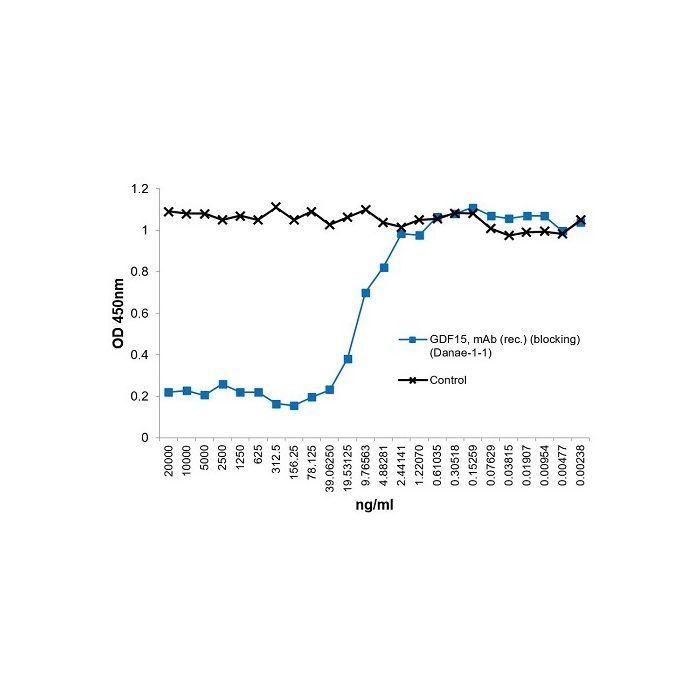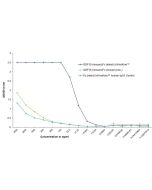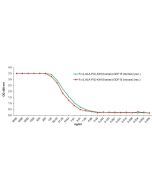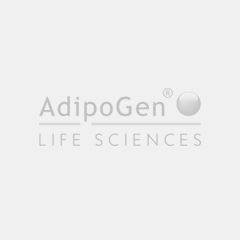Cookie Policy: This site uses cookies to improve your experience. You can find out more about our use of cookies in our Privacy Policy. By continuing to browse this site you agree to our use of cookies.
AdipoGen Life Sciences
anti-GDF15, mAb (rec.) (blocking) (Danae-1-1) (preservative free)

| Product Details | |
|---|---|
| Synonyms | Growth/Differentiation Factor 15; Macrophage Inhibitory Cytokine 1; MIC-1 |
| Product Type | Recombinant Antibody |
| Properties | |
| Clone | Danae-1-1 |
| Isotype | Mouse IgG2b |
| Source/Host | Produced without the use of animals. Purified from HEK 293 cell culture supernatant. |
| Immunogen/Antigen | Mouse recombinant GDF15. |
| Label/Conjugates | Preservative Free |
| Application |
ELISA Functional: Inhibits the binding of mouse GDF15 to its receptor GFRAL. |
| Crossreactivity |
Human Mouse |
| Specificity |
Recognizes mouse and human GDF15. |
| Purity | ≥95% (SDS-PAGE) |
| Purity Detail | Protein A-affinity purified. |
| Endotoxin Content | <0.01EU/μg purified protein (LAL test; Lonza). |
| Concentration | Lot dependent. |
| Formulation | Liquid. In PBS. |
| Isotype Negative Control | |
| Other Product Data |
anti-GDF15, monoclonal antibody (recombinant) (Danae-1-1) is composed of human variable regions (VH and VL) (λ-chain) of immunoglobulin fused to the mouse lgG2b Fc domain. |
| Shipping and Handling | |
| Shipping | BLUE ICE |
| Short Term Storage | +4°C |
| Long Term Storage | -20°C |
| Handling Advice |
After opening, prepare aliquots and store at -20°C. Avoid freeze/thaw cycles. |
| Use/Stability | Stable for at least 1 year after receipt when stored at -20°C. |
| Documents | |
| Product Specification Sheet | |
| Datasheet |
 Download PDF Download PDF |
Growth and differentiation factor 15 (GDF15, also known as macrophage inhibitory cytokine-1 (MIC-1)), is a member of the transforming growth factor (TGF)-β superfamily and was initially identified in activated macrophages. GDF15 acts through a recently identified receptor called Glial-derived Neurotrophic Factor (GDNF) Receptor Alpha-Like (GFRAL), which signals through the Rearranged during Transfection (RET) tyrosine kinase receptor. GDF15 is highly expressed in placenta and brain, and it is expressed at lower levels in kidney, pancreas, prostate and colon. Similar to other TGF-β family proteins, GDF15 is synthesized as a large precursor protein that is cleaved to release the mature protein that shares 66% and 97% amino acid sequence identity with the human and rat proteins, respectively. Biologically active GDF15 is a disulfide-linked homodimer of the mature protein. The effects of GDF-15 are pleiotropic and include appetite regulation, actions on metabolism, pregnancy, cell survival, immune response and inflammation. GDF-15 also plays different roles in the pathophysiology of cardiovascular disease, autoimmunity, cancer-associated anorexia/cachexia and diabetes.
High levels of GDF15 cause anorectic effects and cachexia, largely if not exclusively through the suppression of food intake via modulation of neuropeptide Y and pro-opiomelanocortin levels. Various functions have been reported for GDF15, including inhibition of TNF-α production from lipopolysaccharide-stimulated macrophages and the induction of cartilage formation. GDF15 also promotes neuronal survival. GFRAL and GDF15 signaling are implicated in diet-based obesity and insulin resistance. GDF15 is cardioprotective via inhibition of platelet activation, limiting atherosclerosis, promoting recovery following myocardial infarction and regulating angiogenesis. Recently, GDF15 has also been a key player in human aging. It has been linked to aging-related processes, including cellular senescence and the dysfunction of mitochondria, as well as age-related diseases, such as Alzheimer's disease.








